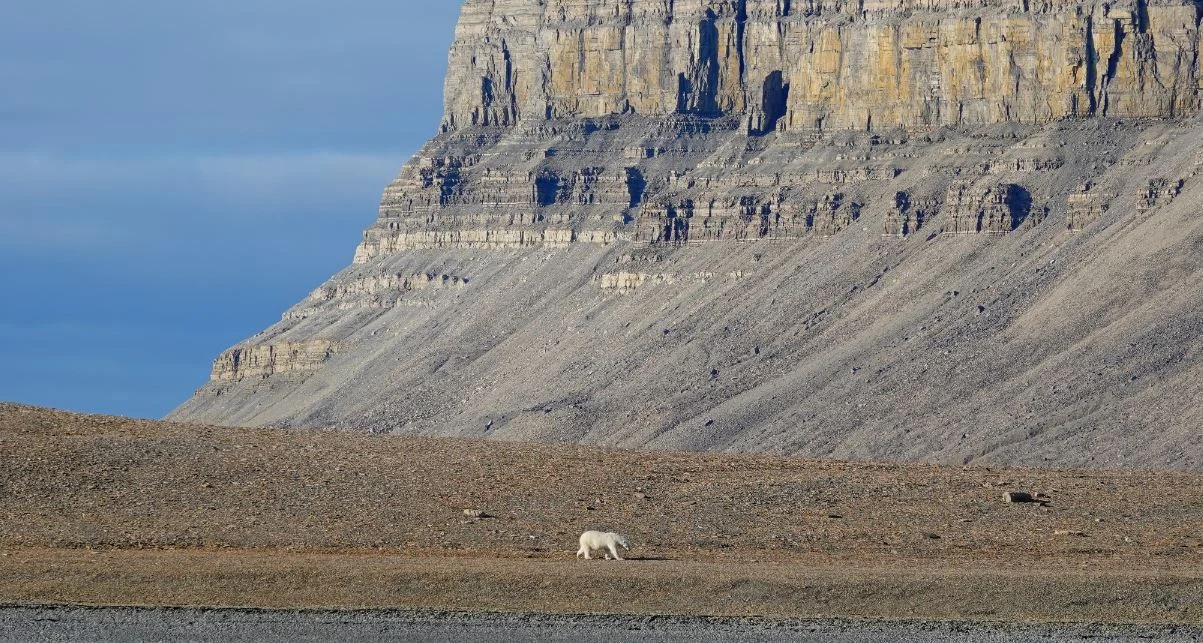Nanuk
/When we got in to the heaviest part, the radar was of little use. Sea ice stretched out as far as we could see, not as a solid mass but as individual sheets, low and flat, some a few meters long others as large as Rosehearty. The radar display was jammed with echoes in no discernible order The location of the ice was forecast correctly on the Canadian ice service chart; the density, however, was not. Hutch took the helm at 2200, joined by Ethan and our Ice Pilot, Germaine. On the previous watch, Hugo and I had to contend with a two mile wide section of what are referred to as ice strips. We had to slow down for a short period, hand steer and pick our lanes through. But this section of strips was relatively narrow, the strips not so large, and within a half an hour we were back up to speed and in relatively open water. About 45 minutes after Hutch and his team took over, the seascape changed dramatically. Little by little the open water became more cluttered; lanes narrowed until the ice sheets formed a kind of puzzle, not quite interlocking but, with very little space between them. From 2200 to 0330 Hutch remained at the helm; Germain backed him up. Ethan, in his warmest gear, was the lookout on the bow until 0200 and was then relieved by Kiwi Mark. At 0230 I heard the engines in full astern; the thruster rumbled, a chunk of ice thumped its way down the port side. Hutch had stopped the boat. I went topside. We were only 4 miles from our destination but the lane that Hutch had chosen had disappeared. At our briefing before setting off from Croker Bay, we had discussed the possibility that we might not be able to make it all the way to our target anchorage at Blanely Bay. We had just covered 68 of the 72 miles; were we going to have to turn around? Fortunately another alley was opening, just as the one was closing and so after a short period of moving astern and a bit more bow thruster to swing the head, Hutch had the boat pointed where he wanted and we set off slowly once again. Rosehearty ghosted out of ice around a low rocky spit and in to our anchorage area. Clearly relieved, but still operating on a plane of heightened awareness, Hutch gave the order to Mark on the bow, "Let go port anchor, 3 shots lazy brake then, out to 5 on a long stay." We had made it to Blanely Bay. Over coffees in the crew mess, Hutch noted, “That was pretty much the upper limit of what this boat and crew would want to contend with.” With that succinct assessment, he stood up, bade us good night and retired to his cabin.
Hugo and I were left on deck with the boss, who had been on the flybridge most of the night, watching his boat sneak through the floes of sea ice. The evening cloud had cleared. The sun blazed, striking the still water, flashing off the few bergy bits that were in the bay. Off our stern was a stunning glacier, much smaller in width than those we had seen in Croker Bay but impressive in another way: the river of ice was so steep that from the deck we could see not only the face and piled up frontal layers but we also had a view of the entire frozen river from the sea up to the top of the mountain from which it flowed. The glacier unwound from the mountain top like a wide snake, nestled between the high walls of a dark canyon. Hoodoos stood guard in perfectly straight rows. The water in the bay was the color of obsidian.
And then we spotted her: a lone polar bear crouched on a rocky hill; several walrus were in the water where the rocky spit touched the sea. The bear had a clear view of the walrus. And we had a clear view of the bear. This was our first bear sighting. The polar bear, Ursus Maritimus or Nanuk in the Inuit language, is the largest of the land carnivores, weighing up to 500 pounds, and, when standing on its hind legs, towering 12 feet above the ground. One guide book suggested that polar bears may lead the loneliest life of any mammal on the planet. They meet other bears for courtship only and after that take no further part in family life. When the anchor tumbled out of the pocket, the polar bear lifted his head, put his nose in the air and took a few deep breaths, then walked slowly down to the water with a lazy, lumbering gate. He paused to yawn, giving us a glimpse at how wide he could open his jaws. Catherine had just come on duty and may have been the most excited. “Ahh’ve never seen a polar bear in my laaf!” she squealed in that crisp and musical Afrikaans accent. “Oh, maah wurd she is stunning.” The walrus left. The bear paused at the water’s edge. He began to lick the surface gingerly, not plunging his tongue but delicately running it along the surface. I surmised that there must be a layer of fresh water on the top of the salt water, a thin lens from which the bear could slake his thirst. Hydrated, the bear entered the water and swam around the small spit and out of sight, leaving us alone with the glacier and the hoodoos of Blanely Bay.
— Jonathan
A tender expedition led by Ken Burton encountered same the bear a few hours later. I am told that Jerry Herring and several others have some excellent photos that we will post in a few hours.
Photo by Kiwi Mark
Photo by Ethan
Photo by Ethan
Photo b y Ethan
Photo by Hugo
Photo by Hugo







